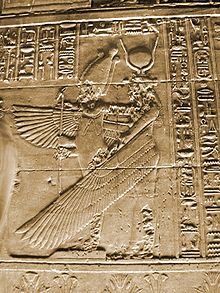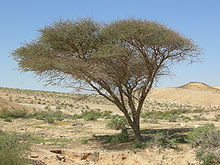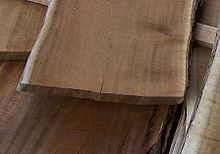- Acacia
-
"Wattles" redirects here. For the author, see Wallace Wattles. For other uses, see Wattle (disambiguation).
Acacia 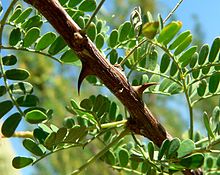
Acacia greggii Scientific classification 
Kingdom: Plantae clade: Angiosperms clade: Eudicots clade: Rosids Order: Fabales Family: Fabaceae Subfamily: Mimosoideae Tribe: Acacieae Genus: Acacia
Mill.[1]Species About 1,300; see List of Acacia species
Acacia (
 /əˈkeɪʃə/ or /əˈkeɪsiə/) is a genus of shrubs and trees belonging to the subfamily Mimosoideae of the family Fabaceae, first described in Africa by the Swedish botanist Carl Linnaeus in 1773. Many non-Australian species tend to be thorny, whereas the majority of Australian acacias are not. They are pod-bearing, with sap and leaves typically bearing large amounts of tannins and condensed tannins that historically in many species found use as pharmaceuticals and preservatives.
/əˈkeɪʃə/ or /əˈkeɪsiə/) is a genus of shrubs and trees belonging to the subfamily Mimosoideae of the family Fabaceae, first described in Africa by the Swedish botanist Carl Linnaeus in 1773. Many non-Australian species tend to be thorny, whereas the majority of Australian acacias are not. They are pod-bearing, with sap and leaves typically bearing large amounts of tannins and condensed tannins that historically in many species found use as pharmaceuticals and preservatives.The generic name derives from ακακία (akakia), the name given by early Greek botanist-physician Pedanius Dioscorides (ca. 40-90) to the medicinal tree A. nilotica in his book Materia Medica.[2] This name derives from the Greek word for its characteristic thorns, ακις (akis, thorn).[3] The species name nilotica was given by Linnaeus from this tree's best-known range along the Nile river.
Acacias are also known as thorntrees, whistling thorns or wattles, including the yellow-fever acacia and umbrella acacias.
The genus Acacia previously contained roughly 1300 species, about 960 of them native to Australia, with the remainder spread around the tropical to warm-temperate regions of both hemispheres, including Europe, Africa, southern Asia, and the Americas. However, in 2005 the genus was divided into five separate genera. The name Acacia was retained for the majority of the Australian species and a few in tropical Asia, Madagascar and Pacific Islands. Most of the species outside Australia, and a small number of Australian species, were reclassified into Vachellia and Senegalia. The two final genera, Acaciella and Mariosousa, only contain about a dozen species from the Americas each.
Contents
Classification
The traditional circumscription of the genus Acacia is not monophyletic. This discovery has led to the breaking up of Acacia into five genera as discussed in: List of Acacia species. At the 17th International Botanical Congress in Vienna, 2005, the much debated re-typification of the genus with an Australian species (which was validated by the 18th IBC in Melbourne, 2011) most of the traditional acacias of Africa are now treated in the genera Vachellia and Senegalia, while some of the American species are placed in Acaciella and Mariosousa. The majority of species still treated in the genus Acacia are confined to Australia. In common parlance, the term "acacia" is occasionally misapplied to species of the genus Robinia, which also belongs in the pea family. Robinia pseudoacacia, an American species locally known as Black Locust, is sometimes called "false acacia" in cultivation in the United Kingdom.
Geography
Acacias in Australia probably evolved their fire resistance about 20 million years ago when fossilised charcoal deposits show a large increase, indicating that fire was a factor even then.[citation needed] With no major mountain ranges or rivers to prevent their spread, the wattles began to spread all over the continent as it dried and fires became more common.[citation needed] They began to form dry, open forests with species of the genera Casuarina, Eucalyptus and Callitris (Cypress-pines).
The southernmost species in the genus are Acacia dealbata (Silver Wattle), Acacia longifolia (Coast Wattle or Sydney Golden Wattle), Acacia mearnsii (Black Wattle), and Acacia melanoxylon (Blackwood), reaching 43°30' S in Tasmania, Australia, while Acacia caven (Espinillo Negro) reaches nearly as far south in northeastern Chubut Province of Argentina.[citation needed]
Australian species are usually called wattles, while African and American species tend to be known as acacias.[citation needed]
Acacia albida, Acacia tortilis and Acacia iraqensis can be found growing wild in the Sinai desert and the Jordan valley. It[clarification needed] is found in the savanna vegetation of the tropical continental climate. It grows wild in Montserrat West Indies; there it is locally referred to as 'cusha.'
Description
The leaves of acacias are compound pinnate in general. In some species, however, more especially in the Australian and Pacific islands species, the leaflets are suppressed, and the leaf-stalks (petioles) become vertically flattened, and serve the purpose of leaves. These are known as phyllodes. The vertical orientation of the phyllodes protects them from intense sunlight, as with their edges towards the sky and earth they do not intercept light so fully as horizontally placed leaves. A few species (such as Acacia glaucoptera) lack leaves or phyllodes altogether, but possess instead cladodes, modified leaf-like photosynthetic stems functioning as leaves.
The small flowers have five very small petals, almost hidden by the long stamens, and are arranged in dense globular or cylindrical clusters; they are yellow or cream-colored in most species, whitish in some, even purple (Acacia purpureapetala) or red (Acacia leprosa Scarlet Blaze). Acacia flowers can be distinguished from those of a large related genus, Albizia, by their stamens which are not joined at the base. Also, unlike individual Mimosa flowers, those of Acacia have more than 10 stamens.[4]
The plants often bear spines, especially those species growing in arid regions. These sometimes represent branches which have become short, hard and pungent, or sometimes leaf-stipules. Acacia armata is the Kangaroo-thorn of Australia and Acacia erioloba is the Camelthorn of Africa.
Acacia seeds can be difficult to germinate. Research has found that immersing the seeds in various temperatures (usually around 80 °C) and manual seed coat chipping can improve yields to approximately 80 percent.[5]
Symbiosis


Acacia collinsii stipules In the Central American Acacia sphaerocephala, Acacia cornigera, and Acacia collinsii (collectively known as the bullthorn acacias), the large thorn-like stipules are hollow and afford shelter for several species of Pseudomyrmex ants, which feed on a secretion of sap on the leaf-stalk and small, lipid-rich food-bodies at the tips of the leaflets called Beltian bodies. In return, the ants add protection to the plant against herbivores.[6] Some species of ants will also fight off competing plants around the acacia, cutting off the offending plant's leaves with their jaws and ultimately killing it. Other associated ant species appear to do nothing to benefit their hosts.
Similar mutualisms with ants occur on Acacia trees in Africa, such as the Whistling Thorn acacia. The acacias provide shelter for ants in the hollow stipules and nectar in extrafloral nectaries for their symbiotic ants such as Crematogaster mimosae. In turn, the ants protect the plant by attacking large mammalian herbivores and stem-boring beetles that damage the plant.
Pests
In Australia, Acacia species are sometimes used as food plants by the larvae of hepialid moths of the genus Aenetus including A. ligniveren. These burrow horizontally into the trunk then vertically down. Other Lepidoptera larvae which have been recorded feeding on Acacia include Brown-tail, Endoclita malabaricus and Turnip Moth. The leaf-mining larvae of some bucculatricid moths also feed on Acacia: Bucculatrix agilis feeds exclusively on Acacia horrida and Bucculatrix flexuosa feeds exclusively on Acacia nilotica.
Acacias contain a number of organic compounds that defend them from pests and grazing animals.[7]
Uses
Food uses
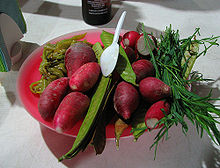 Acacia seed pods,[clarification needed] also known as Guajes, served as part of a botana in Oaxaca, Mexico.
Acacia seed pods,[clarification needed] also known as Guajes, served as part of a botana in Oaxaca, Mexico.


Acacia dealbata seeds Acacia seeds are often used for food and a variety of other products.
In Burma, Laos and Thailand, the feathery shoots of Acacia pennata (common name cha-om, ชะอม and su pout ywet in Burmese) are used in soups, curries, omelettes, and stir-fries.
In Mexico the seeds are known as Guajes. Guajes or huajes are the flat, green pods of an acacia tree. The pods are sometimes light green or deep red in color—both taste the same. Guaje seeds are about the size of a small lima bean and are eaten raw with guacamole, sometimes cooked and made into a sauce. They can also be made into fritters. The ground seeds are used to impart a slightly garlicy flavor to a mole called guaxmole (huaxmole). The dried seeds may be toasted and salted and eaten as a snack referred to as "cacalas".
The predominantly herbivorous spider Bagheera kiplingi, which is found in Central America and Mexico, feeds on nubs at the tips of the acacia leaves, known as Beltian bodies, which contain high concentrations of protein. These nubs are produced by the acacia as part of a symbiotic relationship with certain species of ant, which also eat them.[8]
Acacia is listed as an ingredient in Sun Drop, Fresca, a citrus soft drink, RC Cola, Barq's root beer, Full Throttle Unleaded Energy Drink, Strawberry-Lemonade Powerade[9] as well as in Läkerol pastille candies, Altoids mints, Langer's Pineapple coconut Juice, Wrigley's Eclipse chewing gum and M&Ms Pretzel.
Honey labeled under the term 'Acacia Honey' is a type of honey produced by bees from a false acacia known as black locust in North America, but called by the misnomer 'acacia' in Europe, hence this liquid honey which practically doesn't crystallize does not come from true acacias.
Gum
Various species of acacia yield gum. True gum arabic is the product of Acacia senegal, abundant in dry tropical West Africa from Senegal to northern Nigeria.
Acacia arabica is the gum-Arabic tree of India, but yields a gum inferior to the true gum-Arabic.
Medicinal uses
Many Acacia species have important uses in traditional medicine. Most of the uses have been shown to have a scientific basis since chemical compounds found in the various species have medicinal effects.[citation needed]
In Ayurvedic medicine, Acacia nilotica is considered a remedy that is helpful for treating premature ejaculation. A 19th century Ethiopian medical text describes a potion made from an Ethiopian species of Acacia (known as grar) mixed with the root of the tacha, then boiled, as a cure for rabies.[10]
An astringent medicine high in tannins, called catechu or cutch, is procured from several species, but more especially from Acacia catechu, by boiling down the wood and evaporating the solution so as to get an extract.[11][12] The catechu extract from Acacia catechu figures in the history of chemistry in giving its name to the catechin, catechol, and catecholamine chemical families ultimately derived from it.
Ornamental uses
A few species are widely grown as ornamentals in gardens; the most popular perhaps is Acacia dealbata (Silver Wattle), with its attractive glaucous to silvery leaves and bright yellow flowers; it is erroneously known as "mimosa" in some areas where it is cultivated, through confusion with the related genus Mimosa.
Another ornamental acacia is Acacia xanthophloea (Fever Tree). Southern European florists use Acacia baileyana, Acacia dealbata, Acacia pycnantha and Acacia retinodes as cut flowers and the common name there for them is mimosa.[13]
Ornamental species of acacia are also used by homeowners and landscape architects for home security. The sharp thorns of some species deter unauthorized persons from entering private properties, and may prevent break-ins if planted under windows and near drainpipes. The aesthetic characteristics of acacia plants, in conjunction with their home security qualities, makes them a considerable alternative to artificial fences and walls.
Paints
The ancient Egyptians used Acacia in paints.[14]
Perfume
Acacia farnesiana is used in the perfume industry due to its strong fragrance. The use of Acacia as a fragrance dates back centuries.
Symbolism and ritual
The Acacia is used as a symbol in Freemasonry, to represent purity and endurance of the soul, and as funerary symbolism signifying resurrection and immortality. The tree gains its importance from the description of the burial of Hiram Abiff, the builder of King Solomon's Temple in Jerusalem.[citation needed]
Egyptian mythology has associated the acacia tree with characteristics of the tree of life (see the article on the Myth of Osiris and Isis).
Several parts (mainly bark, root and resin) of Acacia are used to make incense for rituals. Acacia is used in incense mainly in India, Nepal, and China including in its Tibet region. Smoke from Acacia bark is thought to keep demons and ghosts away and to put the gods in a good mood. Roots and resin from Acacia are combined with rhododendron, acorus, cytisus, salvia and some other components of incense. Both people and elephants like an alcoholic beverage made from acacia fruit.[15] According to Easton's Bible Dictionary, the Acacia tree may be the “burning bush” (Exodus 3:2) which Moses encountered in the desert.[16] Also, when God gave Moses the instructions for building the Tabernacle, he said to "make an ark " and "a table of acacia wood" (Exodus 25:10 & 23, Revised Standard Version)
In Russia, Italy and other countries it is customary to present women with yellow mimosas (among other flowers) on International Women's Day (March 8). These "mimosas" are actually from Acacia dealbata (Silver Wattle).
Tannin
The bark of various Australian species, known as wattles, is very rich in tannin and forms an important article of export; important species include Acacia pycnantha (Golden Wattle), Acacia decurrens (Tan Wattle), Acacia dealbata (Silver Wattle) and Acacia mearnsii (Black Wattle).
Black Wattle is grown in plantations in South Africa. Most Australian acacia species introduced to South Africa have become an enormous problem, due to their naturally aggressive propagation. The pods of Acacia nilotica (under the name of neb-neb), and of other African species are also rich in tannin and used by tanners.
Wood
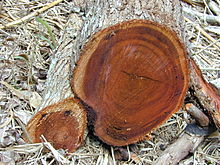

Acacia koa Wood Some Acacia species are valuable as timber, such as Acacia melanoxylon (Blackwood) from Australia, which attains a great size; its wood is used for furniture, and takes a high polish; and Acacia omalophylla (Myall Wood, also Australian), which yields a fragrant timber used for ornaments. Acacia seyal is thought to be the Shittah-tree of the Bible, which supplied shittim-wood. According to the Book of Exodus, this was used in the construction of the Ark of the Covenant. Acacia koa from the Hawaiian Islands and Acacia heterophylla from Réunion island are both excellent timber trees. Depending on abundance and regional culture, some Acacia species (e.g. Acacia fumosa), are traditionally used locally as firewoods.[17]
Pulpwood
In Indonesia (mainly in Sumatra) and in Malaysia (mainly in Sarawak) plantations of Acacia mangium are being established to supply pulpwood to the paper industry.
Acacia gives high opacity and below average bulk paper. This is suitable in lightweight offset papers used for bibles and dictionaries. It is also used in paper tissue where it improves softness.
Land Reclamation
Acacia can be planted for erosion control, especially after mining or construction damage.[18]
Ecological invasion
For the same reasons it is favored as an erosion-control plant, with its easy spreading and resilience, some varieties of acacia, are potentially an invasive species. One of the most globally significant invasive Acacias is Black Wattle Acacia mearnsii, which is taking over grasslands and abandoned agricultural areas worldwide, especially in moderate coastal and island regions where mild climate promotes its spread. Australian/New Zealand Weed Risk Assessment gives it a "high risk, score of 15" rating and it is considered one of the world's 100 most invasive species.[19] Extensive ecological studies should be performed before further introduction of acacia varieties as this fast-growing Genus, once introduced, spreads fast and is extremely difficult to eradicate.
Phytochemistry of Acacia
Alkaloids
As mentioned previously, Acacias contain a number of organic compounds that defend them from pests and grazing animals.[7] Many of these compounds are psychoactive in humans. The alkaloids found in Acacias include dimethyltryptamine (DMT), 5-methoxy-dimethyltryptamine (5-MeO-DMT) and N-methyltryptamine (NMT). The plant leaves, stems and/or roots are sometimes made into a brew together with some MAOI-containing plant and consumed orally for healing, ceremonial or religious uses.
Cyanogenic glycosides
Nineteen different species of Acacia in the Americas contain cyanogenic glycosides, which, if exposed to an enzyme which specifically splits glycosides, can release hydrogen cyanide (HCN) in the acacia "leaves."[20] This sometimes results in the poisoning death of livestock.
If fresh plant material spontaneously produces 200 ppm or more HCN, then it is potentially toxic. This corresponds to about 7.5 μmol HCN per gram of fresh plant material. It turns out that, if acacia "leaves" lack the specific glycoside-splitting enzyme, then they may be less toxic than otherwise, even those containing significant quantities of cyanic glycosides.[21]
Some Acacia species containing cyanogens:
- Acacia erioloba
- Acacia cunninghamii
- Acacia obtusifolia
- Acacia sieberiana
- Acacia sieberiana var. woodii[22]
Species
There are over 1,300 species of Acacia. See List of Acacia species for a more complete listing.
Famous acacia
Perhaps the most famous acacia is the Arbre du Ténéré in Niger. The reason for the tree's fame is that it used to be the most isolated tree in the world, approximately 400 km (249 mi) from any other tree. The tree was knocked down by a truck driver in 1973.
See also
Notes
- ^ Genus: Acacia Mill. - Germplasm Resources Information Network (GRIN)
- ^ "Acacia nilotica (acacia)". Plants & Fungi. Royal Botanic Gardens, Kew. http://www.kew.org/plants-fungi/Acacia-nilotica.htm. Retrieved 2010-01-28.
- ^ Quattrocchi, Umberto (2000). CRC World Dictionary of Plant Names. 1 A-C. CRC Press. p. 6. ISBN 978-0-8493-2675-2. http://books.google.com/?id=esMPU5DHEGgC.
- ^ Singh, Gurcharan (2004). Plant Systematics: An Integrated Approach. Science Publishers. p. 445. ISBN 978-1-57808-351-0. http://books.google.com/?id=In_Lv8iMt24C.
- ^ J Clemens, PG Jones, NH Gilbert (1977). "Effect of seed treatments on germination in Acacia". Australian Journal of Botany 25 (3): 269–267. doi:10.1071/BT9770269. http://www.publish.csiro.au/nid/65/paper/BT9770269.htm.
- ^ "Evolutionary change from induced to constitutive expression of an indirect plant resistance : Abstract : Nature". www.nature.com. http://www.nature.com/nature/journal/v430/n6996/abs/nature02703.html. Retrieved 2008-04-20.
- ^ a b Chemistry of Acacias from South Texas
- ^ Meehan, Christopher J.; Olson, Eric J.; Curry, Robert L. (21 August 2008): Exploitation of the Pseudomyrmex–Acacia mutualism by a predominantly vegetarian jumping spider (Bagheera kiplingi). The 93rd ESA Annual Meeting.
- ^ Powerade Ion4 Sports Drink, B Vitamin Enhanced, Strawberry Lemonade | Wegmans
- ^ Richard Pankhurst, An Introduction to the Medical History of Ethiopia (Trenton: Red Sea Press, 1990), p. 97
- ^ An OCR'd version of the US Dispensatory by Remington and Wood, 1918.
- ^ [1] Cutch and catechu plant origin from the Food and Agriculture (FAO) department of the United Nations. Document repository accessed Nov. 5, 2011
- ^ World Wide Wattle
- ^ Excerpt from A Consumer's Dictionary of Cosmetic Ingredients: Fifth Edition (Paperback) Amazon.com
- ^ Naturheilpraxis Fachforum (German)[dead link]
- ^ Easton's Bible Dictionary: Bush
- ^ Maugh, T.H.II. (2009-04-24). "New species of tree identified in Ethiopia". Los Angeles Times. http://www.latimes.com/news/nationworld/nation/la-sci-tree25-2009apr25,0,402549.story. Retrieved 2008-04-24.
- ^ Barr, D. A., and Atkinson, W. J. (1970). "Stabilization of coastal sands after mining". J. Soil Conserv. Serv. N.S.W. 26: 89–105..
- ^ Acacia mearnsii (PIER species info)
- ^ Cyanogenic Glycosides in Ant-Acacias of Mexico and Central America David S. Seigler, John E. Ebinger The Southwestern Naturalist, Vol. 32, No. 4 (December 9, 1987), pp. 499-503 doi:10.2307/3671484
- ^ Chemotaxonomie der Pflanzen By Robert Hegnauer
- ^ FAO Kamal M. Ibrahim, The current state of knowledge on Prosopis juliflora...[dead link]
General references
- Clement, B.A., Goff, C.M., Forbes, T.D.A. Toxic Amines and Alkaloids from Acacia rigidula, Phytochem. 1998, 49(5), 1377.
- Shulgin, Alexander and Ann, TiHKAL the Continuation. Transform Press, 1997. ISBN 978-0-9630096-9-2
External links
- Acacia at the Encyclopedia of Life
- World Wide Wattle
- Acacia-world
- Wayne's Word on "The Unforgettable Acacias"
- The genus Acacia and Entheogenic Tryptamines, with reference to Australian and related species, by mulga
- A description of Acacia from Pomet's 1709 reference book, History of Druggs
- Dr. Duke's Phytochemical and Ethnobotanical Databases
- Flora identification tools from the State Herbarium of South Australia
- Tannins in Some Interrelated Wattles
- List of Acacia Species in the U.S.
- FAO Timber Properties of Various Acacia Species
- FAO Comparison of Various Acacia Species as Forage
- Long-term effects of roller chopping on antiherbivore defenses in three shrub species, Jason R. Schindlera, Timothy E. Fulbright
- Vet. Path. ResultsAFIP Wednesday Slide Conference - No. 21 February 24, 1999
- Acacia cyanophylla lindl as supplementary feed/for small stock in Libya
- Description of Acacia Morphology
- Nitrogen Fixaton in Acacias
- Acacias with Cyagenic Compounds
- Acacia Alarm System
- Acacia in West African plants - A Photo Guide.
Categories:- Acacia
- Excipients
Wikimedia Foundation. 2010.



